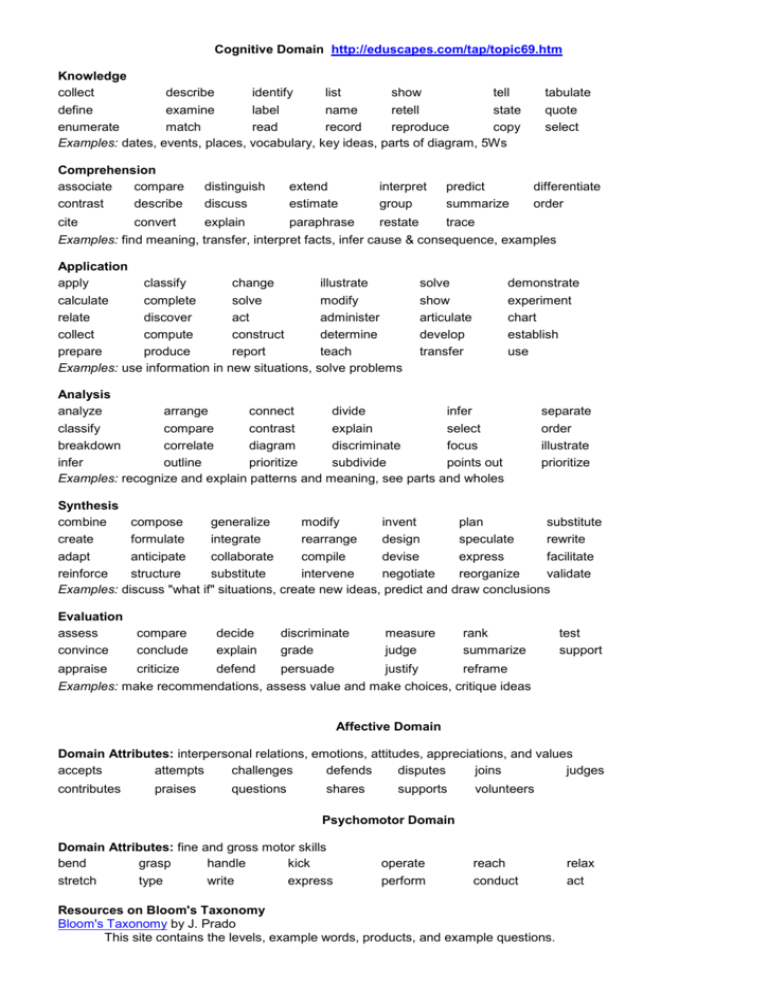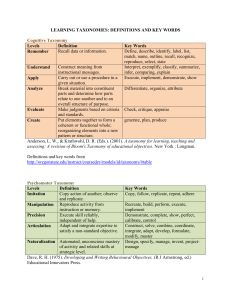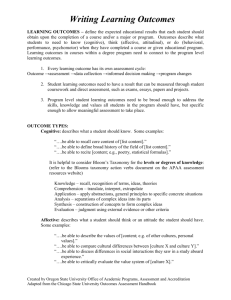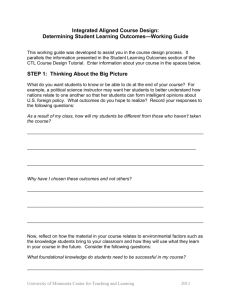Critical Thinking Skills
advertisement

Cognitive Domain http://eduscapes.com/tap/topic69.htm Knowledge collect describe identify list show tell define examine label name retell state enumerate match read record reproduce copy Examples: dates, events, places, vocabulary, key ideas, parts of diagram, 5Ws Comprehension associate compare contrast describe distinguish discuss extend estimate interpret group predict summarize tabulate quote select differentiate order cite convert explain paraphrase restate trace Examples: find meaning, transfer, interpret facts, infer cause & consequence, examples Application apply classify change illustrate calculate complete solve modify relate discover act administer collect compute construct determine prepare produce report teach Examples: use information in new situations, solve problems solve show articulate develop transfer demonstrate experiment chart establish use Analysis analyze arrange connect divide infer classify compare contrast explain select breakdown correlate diagram discriminate focus infer outline prioritize subdivide points out Examples: recognize and explain patterns and meaning, see parts and wholes separate order illustrate prioritize Synthesis combine compose generalize modify invent plan substitute create formulate integrate rearrange design speculate rewrite adapt anticipate collaborate compile devise express facilitate reinforce structure substitute intervene negotiate reorganize validate Examples: discuss "what if" situations, create new ideas, predict and draw conclusions Evaluation assess convince compare conclude decide explain discriminate grade measure judge rank summarize test support appraise criticize defend persuade justify reframe Examples: make recommendations, assess value and make choices, critique ideas Affective Domain Domain Attributes: interpersonal relations, emotions, attitudes, appreciations, and values accepts attempts challenges defends disputes joins judges contributes praises questions shares supports volunteers Psychomotor Domain Domain Attributes: fine and gross motor skills bend grasp handle kick stretch type write express operate perform reach conduct Resources on Bloom's Taxonomy Bloom's Taxonomy by J. Prado This site contains the levels, example words, products, and example questions. relax act Other Sites with an Overview and Key Words: Bloom's Taxonomy: An Overview from Family Education Network's TeacherVision Taxonomy of Educational Objectives developed by A. Harrow, adapted by T. Allen This page provides sample questions. Learning Skills Program: Bloom's Taxonomy from University of Victoria This page lists the six levels of the cognitive domain with examples. Other Sites Listing the Taxonomy: Designing and Managing MCQs from University of Cape Town, South Africa Major Categories in the Taxonomy of Educational Objectives by G. Krumme, University of Washington, Seattle Question Types Based on Bloom's Taxonomy from University of Colorado Bloom's Taxonomy from University of Mississippi Critical Thinking Across the Curriculum by B. Fowler, Longview Community College Explore the questions associated with each Bloom category. Critical Thinking Resources Critical Thinking from The University of Tennessee at Chattanooga This webpage provides an overview of critical thinking. Critical Thinking on the Web by T. van Gelder at The University of Melbourne This links page provide connects to lots of teaching and learning resources related to critical thinking. Free Brainstorming Training from Infinite Innovations Ltd Learn basic and advanced techniques for brainstorming. Mission: Critical from San Jose State University This website provides an advanced look at critical thinking and specifically analysis of arguments and persuasion. Examples and Applications of Critical Thinking Evaluating Primary Sources from Library of Congress's American Memory This website does a great job providing an example of using Bloom's Taxonomy for evaluating primary resource materials. Integrating Critical Thinking Skills Into the Classroom by A. Buchanan This article defines critical thinking and provides steps for integrating the ideas into the classroom. Layered Curriculum by K.F. Nunley The Layered Curriculum approach focuses on increasing levels of complexity. Explore some of the many examples. What Is a Thinking Curriculum? by T.F. Fennimore & M.B. Tinzmann, North Central Regional Educational Laboratory (NCREL) Join the authors in exploring the characteristics of a "thinking curriculum." Creative Thinking Resources Creativity Links by C. Osborne This page links to great resources on creative thinking. Creative Problem Solving from Burris Laboratory School, Muncie, IN This page highlights six steps in creative problem solving. Creativity Web from C. Cave This page contains ideas on linking creative thinking to critical thinking and multiple intelligences. Within this Website: Six Hats of Thinking by S. Labelle Techniques for Creative Thinking Edward de Bono's Methods & Concepts of Lateral Thinking This page provides an overview of deBono's ideas about creativity. Here you can also learn about the Six Thinking Hats. Introduction to Creative Thinking by R. Harris from VirtualSalt This page compares critical and creative thinking and discusses the myths of creative thinking. Inventive Thinking Curriculum Model from The United States Patent and Trademark Office This page provides ideas for invention and creative thinking. Classic Lateral Thinking Puzzles by P. Sloane and adapted by A. Ottens A collection of thinking puzzles is found on this page. Tutorial on Creativity, Brainstorming and Innovation from Infinite Innovations Ltd. This tutorial provides basic information about creativity, brainstorming, and innovation. It also provides ideas and activities. Creativity Pool This is a database of creative and original ideas. Submit your own or check to see if someone else has thought of the same thing. Bloom's Taxonomy http://cs1.mcm.edu/~awyatt/csc3315/bloom.htm Bloom's Taxonomy is a way to classify instructional activities or questions as they progress in difficulty. The lower levels require less in the way of thinking skills. As one moves down the hierarchy, the activities require higher level thinking skills. Level Type of Activity or Question Verbs Used for Objectives Lowest level Knowledge define, memorize, repeat, record, list, recall, name, relate, collect, label, specify, cite, enumerate, tell, recount Comprehension restate, summarize, discuss, describe, recognize, explain, express, identify, locate, report, retell, review, translate Application exhibit, solve, interview, simulate, apply, employ, use, demonstrate, dramatize, practice, illustrate, operate, calculate, show, experiment Analysis interpret, classify, analyze, arrange, differentiate, group, compare, organize, contrast, examine, scrutinize, survey, categorize, dissect, probe, inventory, investigate, question, discover, text, inquire, distinguish, detect, diagram, inspect Synthesis compose, setup, plan, prepare, propose, imagine, produce, hypothesize, invent, incorporate, develop, generalize, design, originate, formulate, predict, arrange, contrive, assemble, concoct, construct, systematize, create Evaluation judge, assess, decide, measure, appraise, estimate, evaluate, infer, rate, deduce, compare, score, value, predict, revise, choose, conclude, recommend, select, determine, criticize Higher levels Example Product list: Advertisement Annotated bibliography Art gallery Biography Blueprint Board game Book Cover Bulletin board Card game Chart Collage Collection with illustration Collection with narrative Comic Strip Computer program Crossword puzzle Debate Detailed illustration Diary Diorama Display Drama Dramatic monologue Editorial Essay Experiment Experiment Log Fable Fact file Fairy tale Family tree Glossary Graph Graphic design Greeting card Illustrated story Journal Labeled diagram Large scale drawing Lecture Letter Letter to the editor Lesson Line drawing Magazine article Map Map with legend Mobile Monograph Museum exhibit Musical composition News report Pamphlet Pattern with instructions Photo essay Picture dictionary Poem Poster Reference file Powerpoint Presentation Survey Transparency of overhead Vocabulary List Written report Critical Thinking Skills Paul, Binker, Jensen, and Kreklau (1990) have developed a list of 35 dimensions of critical thought: A. Affective Strategies S-1 thinking independently S-2 developing insight into egocentricity or sociocentricity S-3 exercising fair-mindedness S-4 exploring thoughts underlying feelings and feelings underlying thoughts S-5 developing intellectual humility and suspending judgment S-6 developing intellectual courage S-7 developing intellectual good faith or integrity S-8 developing intellectual perseverance S-9 developing confidence in reason B. Cognitive Strategies--Macro-Abilities S-10 refining generalizations and avoiding oversimplifications S-11 comparing analogous situations: transferring insights to new contexts S-12 developing one's perspective: creating or exploring beliefs, arguments, or theories S-13 clarifying issues, conclusions, or beliefs S-14 clarifying and analysing the meanings of words or phrases S-15 developing criteria for evaluation: clarifying values and standards S-16 evaluating the credibility of sources of information S-17 questioning deeply: raising and pursuing root or significant questions S-18 analysing or evaluating arguments, interpretations, beliefs, or theories S-19 generating or assessing solutions S-20 analysing or evaluating actions or policies S-21 reading critically: clarifying or critiquing texts S-22 listening critically: the art of silent dialogue S-23 making interdisciplinary connections S-24 practicing Socratic discussion: clarifying and questioning beliefs, theories, or perspectives S-25 reasoning dialogically: comparing perspectives, interpretations, or theories S-26 reasoning dialectically: evaluating perspectives, interpretations, or theories C. Cognitive Strategies--Micro-Skills S-27 comparing and contrasting ideals with actual practice S-28 thinking precisely about thinking: using critical vocabulary S-29 noting significant similarities and differences S-30 examining or evaluating assumptions S-31 distinguishing relevant from irrelevant facts S-32 making plausible inferences, predictions, or interpretations S-33 evaluating evidence and alleged facts S-34 recognizing contradictions S-35 exploring implications and consequences" (p. 56) Beane, J. (October, 1991). The middle school: The natural home of the integrated curriculum. Educational Leadership 49(2), 9-13. Benard, B. (1991, August). Fostering resiliency in kids: Protective factors in the family, school, and community. Portland, OR: Western Center for Drug-Free Schools and Communities. Caine, R.N., & Caine, G. (1991). Making connections: Teaching and the human brain. Alexandria, VA: Association for Supervision and Curriculum Development. Drake, S. (1993). Planning integrated curriculum: The call to adventure. Alexandria, VA: Association for Supervision and Curriculum Development. Dryfoos, J. (1990). Adolescents at risk: Prevalence and prevention. New York: Oxford University Press. English, J., & Austin, G. (1989, March). Preventing alcohol and other drug use through curricula: Where we've been and where we're heading. Paper presented at the annual conference of the American Education Research Association, San Francisco, CA. Fennimore, T.F., & Tinzmann, M.B. (1990). What is a thinking curriculum? [On-line]. Available: http://www.ncrel.org/sdrs/areas/rpl_esys/thinking.htm Fogarty, R. (1991). The mindful school: How to integrate the curricula. Palatine, IL: IRI/Skylight Publishing. Gibbs, J. (1986, April). A review of current research and state of the art strategies to prevent and disrupt the use of alcohol and other drugs by children and youth. Lakewood, CO: Prevention Center of Boulder, Colorado. Gibbs, J., & Bennett, S. (1990). Together we can reduce the risks of alcohol and drug abuse among youth. Seattle, WA: Comprehensive Health Education Foundation. Hixson, J. (1994). Making the case for integrating prevention and restructuring initiatives. In Student Assistance for the 21st Century (pp. 41-44). Oak Brook, IL: Midwest Regional Center for Drug-Free Schools and Communities. Jones, B.F., Palinscar, A.S., Ogle, D.S., & Carr, E.G. (1987). Learning and thinking. In Strategic teaching and learning: cognitive instruction in the content areas (pp. 3-32). Alexandria, VA: Association for Supervision and Curriculum Development. Linquanti, R. (1992). Using community-wide collaboration to foster resiliency in kids: A conceptual framework. San Francisco, CA; Western Regional Center for Drug-Free Schools and Communities, Far West Laboratory for Educational Research and Development. National Commission on Drug Free Schools. (1990). Toward a drug-free generation: A nation's responsibility. Washington, DC: U.S. Department of Education. North Central Regional Educational Laboratory. (1992). About story 2: Mt. Carmel/Wabash County, Illinois, and its schools. In Schools that work: The research advantage, guidebook 6: Preparing students for drug-free lifestyles (pp.26-27). Oak Brook, IL: Author. Office of Substance Abuse Prevention, Division of Community Prevention and Training. (1991). Getting it together: Promoting drug-free communities. A resource guide for developing effective youth coalitions. Rockville, MD: Author. Paul, R., Binker., A., Jensen, K., & Kreklau, H. (1990). Critical thinking handbook: A guide for remodeling lesson plans in language arts, social studies and science. Rohnert Park, CA: Foundation for Critical Thinking. Pittman, K.J. & Cahill, M. (1991, September). A new vision: Promoting youth development. Paper presented to the House Select Committee on Children, Youth, and Families on September 30, 1991. Pittman, K.J., & Cahill, M. (1992, January). Youth and caring: The role of youth programs in the development of caring. Paper commissioned by the Lilly Endowment Research Grants Program on Youth and Caring and presented at the Conference on Youth and Caring in February 1992. Tinzmann, M.D., & Hixson, J. (1992). What does research say about prevention [On-line]. Available: http://www.ncrel.org/sdrs/areas/stw_esys/6prevntn.htm Tinzmann, M.B., Jones, B.F., Fennimore, T.F., Bakker, J., Fine, C., & Pierce, J. (1990). What is the collaborative classroom? [On-line]. Available: http://www.ncrel.org/sdrs/areas/rpl_esys/collab.htm Voorhees, C.V., & Burke, S.V. (1995, May). Safe and drug-free schools recognition program: 1994-95 winning school abstracts. Oak Brook, IL: North Central Regional Educational Laboratory. Western Regional Center for Drug-Free Schools and Communities, Northwest Regional Educational Laboratory. (1991, January). Curriculum infusion. Oak Brook, IL: Midwest Regional Center for DrugFree Schools and Communities. Wisconsin Department of Public Instruction. (1992). A guide to curriculum planning in alcohol and other drug abuse prevention programs. Madison, WI: Author. Yen, F. B., & Brinkerhoff, C. V. (Eds.). (1992). School program self-assessment instrument. In Evaluation resource notebook for AOD coordinators (pp.7-13 - 7-19). Portland, OR: Western Cegional Center for Drug-Free Schools and Communities, Northwest Regional Educational Laboratory. Available online (requires Adobe Acrobat software): http://www.nwrac.org/pub/library/e/e_evaluat.pdf info@ncrel.org Excellent resources from http://www.au.af.mil/au/awc/awcgate/awc-thkg.htm#create from : http://www.mycoted.com/Category:Creativity_Techniques Interesting site on application of 3D problem solving strategy http://www.mycoted.com/Sculptures Mother Site: http://www.au.af.mil/au/awc/awcgate/awc-thkg.htm Umbrella Site: creativity & thinking skills American Airforce Training








